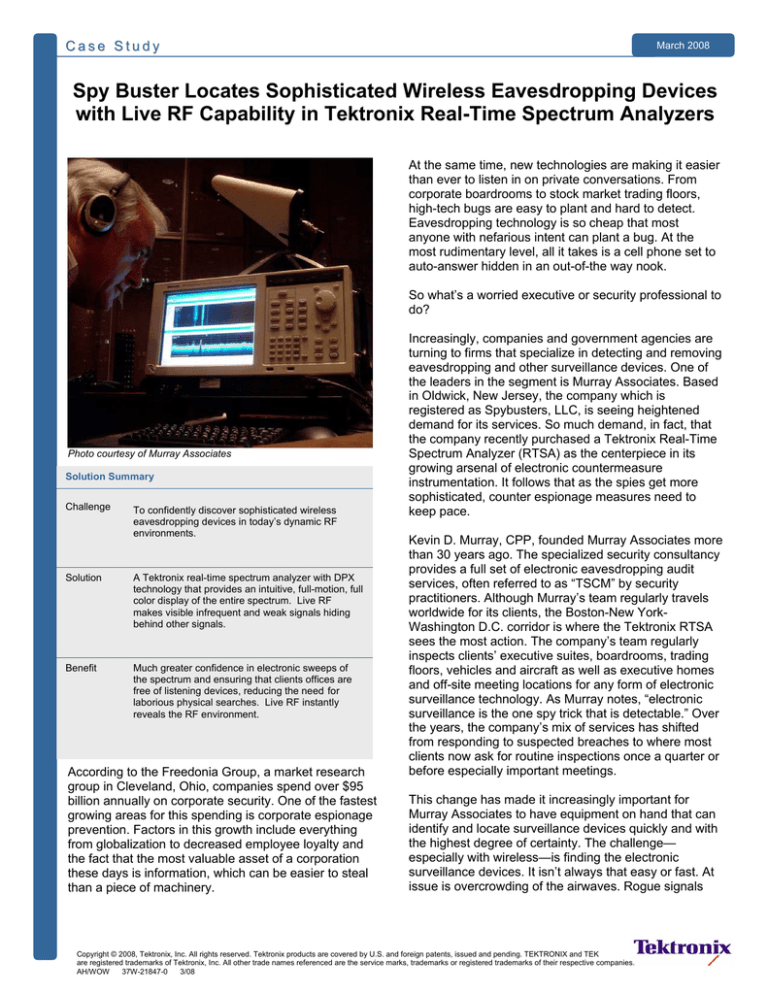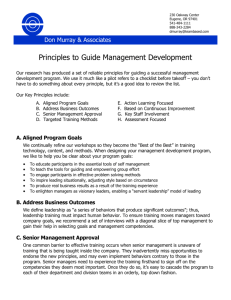
Case Study
March 2008
Spy Buster Locates Sophisticated Wireless Eavesdropping Devices
with Live RF Capability in Tektronix Real-Time Spectrum Analyzers
At the same time, new technologies are making it easier
than ever to listen in on private conversations. From
corporate boardrooms to stock market trading floors,
high-tech bugs are easy to plant and hard to detect.
Eavesdropping technology is so cheap that most
anyone with nefarious intent can plant a bug. At the
most rudimentary level, all it takes is a cell phone set to
auto-answer hidden in an out-of-the way nook.
So what’s a worried executive or security professional to
do?
Photo courtesy of Murray Associates
Solution Summary
Challenge
To confidently discover sophisticated wireless
eavesdropping devices in today’s dynamic RF
environments.
Solution
A Tektronix real-time spectrum analyzer with DPX
technology that provides an intuitive, full-motion, full
color display of the entire spectrum. Live RF
makes visible infrequent and weak signals hiding
behind other signals.
Benefit
Much greater confidence in electronic sweeps of
the spectrum and ensuring that clients offices are
free of listening devices, reducing the need for
laborious physical searches. Live RF instantly
reveals the RF environment.
According to the Freedonia Group, a market research
group in Cleveland, Ohio, companies spend over $95
billion annually on corporate security. One of the fastest
growing areas for this spending is corporate espionage
prevention. Factors in this growth include everything
from globalization to decreased employee loyalty and
the fact that the most valuable asset of a corporation
these days is information, which can be easier to steal
than a piece of machinery.
Increasingly, companies and government agencies are
turning to firms that specialize in detecting and removing
eavesdropping and other surveillance devices. One of
the leaders in the segment is Murray Associates. Based
in Oldwick, New Jersey, the company which is
registered as Spybusters, LLC, is seeing heightened
demand for its services. So much demand, in fact, that
the company recently purchased a Tektronix Real-Time
Spectrum Analyzer (RTSA) as the centerpiece in its
growing arsenal of electronic countermeasure
instrumentation. It follows that as the spies get more
sophisticated, counter espionage measures need to
keep pace.
Kevin D. Murray, CPP, founded Murray Associates more
than 30 years ago. The specialized security consultancy
provides a full set of electronic eavesdropping audit
services, often referred to as “TSCM” by security
practitioners. Although Murray’s team regularly travels
worldwide for its clients, the Boston-New YorkWashington D.C. corridor is where the Tektronix RTSA
sees the most action. The company’s team regularly
inspects clients’ executive suites, boardrooms, trading
floors, vehicles and aircraft as well as executive homes
and off-site meeting locations for any form of electronic
surveillance technology. As Murray notes, “electronic
surveillance is the one spy trick that is detectable.” Over
the years, the company’s mix of services has shifted
from responding to suspected breaches to where most
clients now ask for routine inspections once a quarter or
before especially important meetings.
This change has made it increasingly important for
Murray Associates to have equipment on hand that can
identify and locate surveillance devices quickly and with
the highest degree of certainty. The challenge—
especially with wireless—is finding the electronic
surveillance devices. It isn’t always that easy or fast. At
issue is overcrowding of the airwaves. Rogue signals
Copyright © 2008, Tektronix, Inc. All rights reserved. Tektronix products are covered by U.S. and foreign patents, issued and pending. TEKTRONIX and TEK
are registered trademarks of Tektronix, Inc. All other trade names referenced are the service marks, trademarks or registered trademarks of their respective companies.
AH/WOW
37W-21847-0
3/08
“Going through spectrum is a tedious process,” says
Murray. “Even after you get through it all, you’re not sure
you’ve seen everything. What if a signal is inside
another and is being blocked in such a way that the
spectrum analyzer can’t pick it up?” For a company like
Murray Associates, uncertainty can be extremely bad for
business.
One reason is that the DPX capability can process more
than 48,000 spectrum measurements per second. This
ensures that Murray can spot short duration events. The
RSA6114A has 100 percent probability of intercepting
and displaying signals as short as 24 microseconds. In
contrast, conventional swept spectrum analyzers
typically don’t exceed 50 spectrum measurements per
second, opening the window for a signal to elude
discovery. The signal discovery advantages of DPX
display technology, according to Murray, are particularly
useful in spotting the unexpected transient anomaly or
finding signals hidden within or behind legitimate
signals.
Similarly Murray faces challenging detection
environments with a lot of noise in the airwaves. One
example is a defense-related client that conducts radar
work on-site and is continually flooded with powerful
radar signals that cause a jamming issue. Murray has
found that traditional swept spectrum analyzers weren’t
up to the task in this environment, forcing his inspection
team to laboriously search every inch of the facility.
Unique to Tektronix RTSA, DPX technology provides an
intuitive, full-motion, full-color display. The use of color
makes it easy to visually identify the noise floor, stronger
signals, weak signals and transients. By contrast, the
monochrome display of a swept analyzer is only able to
capture and display the tallest signals, but not weaker
signals—the ones that are most likely to be an
eavesdropping device.
“Our confidence level is sky high.
Some instruments save time. Others
increase effectiveness. This one does
both.”
– Kevin D. Murray, CPP, founder Murray
For Murray’s team, which needs to conduct sweeps in a
thorough, yet fast and efficient manner to meet
customer demand, the DPX technology has been
nothing short of revolutionary. “With the RTSA we can
immediately see what’s going on,” Murray comments.
“Our confidence level is sky high. Some instruments
save time. Others increase effectiveness. This one does
both.”
can become part of the noise, eluding detection by
standard spectrum analyzers. Or weak signals from a
GSM-based listening device can get overshadowed by
stronger signals and not be detected by traditional
spectrum analyzers.
Associates/Spybusters LLC
Another challenge is that some of the more
sophisticated eavesdropping devices may employ
“store-and-forward” digital technology. This mode of
operation digitizes the sound and compresses the digital
record. Then either at a pre-determined time, or on
command, the device transmits the digital record as a
short burst of modulated RF. These bursts may occur at
random times, so finding them with traditional swept
spectrum analyzers can be almost impossible.
To enhance customer confidence and build trust, Murray
prefers to engage and educate his customers about
counter-espionage technology and instrumentation.
While traditional spectrum analyzers offer a visual
display, it’s a dull monochrome display that provides
little in the way of meaningful information to the nonexpert.
DPX Technology Delivers the Full Picture
To dramatically increase his level of confidence in
pinpointing wireless listening devices, Murray turned to
the Tektronix Real-Time Spectrum Analyzers class of
instruments with their unique live DPX™ spectrum
display. As Murray soon discovered, the DPX capability
is a powerful ally in his mission to track down even the
faintest signal where one shouldn’t be.
One important attribute of surveillance monitoring
equipment is sufficient dynamic range and selectivity to
avoid jamming from large signals closely located to the
desired frequency. Strong interferers or adjacent signals
within the band of interest can create intermodulation in
the analyzer that prevent successful demodulation of the
desired signal. Unwanted intermodulation also tends to
clutter up the spectrum with meaningless signals that
slow the spectrum survey process. The RTSAs, in
contrast, have 73 dB of spurious-free dynamic range at
the full bandwidth, which enables the analyzer to handle
virtually anything spies can come up with.
In the case of the radar manufacturer, the DPX
technology has enabled Murray’s team to easily see
low-level signals despite the presence of strong radar
signals that were jamming traditional spectrum
analyzers. DPX reduce the need to conduct inch-by-inch
physical searches, thus saving time and money while
improving effectiveness.
Another bonus of the DPX view is that it is easily
understood by Murray’s clients. “When we show clients
the RTSA they are first blown away by how much RF
activity there is in their building, and then when they can
see firsthand things like low-noise signals and sudden
spikes, they gain a great deal of confidence in the
technology we’re utilizing,” says Murray.
Among those clients are companies in the financial
services industries. In the wake of recent scandals
around insider trading and the subsequent increase in
regulatory oversight, financial services companies are
employing companies like Murray Associates to keep
sensitive information from leaving the premises. Stock
trading floors, for example, now prohibit the use of all
cell phones during trading hours. With its live DPX
display, the RTSA gives Murray’s team the ability to spot
even the briefest of cellular-band transmissions
instantly.
The Tektronix RTSAs with DPX allow discovery of
signals that are commonplace in Digital RF – and
potentially in corporate boardrooms. “The RTSA has put
us miles ahead,” concludes Murray. “There’s no one
who can touch us. The ability to see signals within
another signal…you’re not going to get that from anyone
else.”
Beyond finding hidden signals, the RTSA can track
down many other signals potentially used in
eavesdropping transmissions, including frequency
hopping signals, spread spectrum signals, Ultra Wide
Band (UWB) signals, burst transmission signals and
unexpected spurious emissions. The instrument also
delivers the ability to analyze digital signals.
“The RTSA has put us miles ahead.
There’s no one who can touch us. The
ability to see signals within another
signal…you’re not going to get that
from anyone else.”
– Kevin D. Murray, CPP, founder Murray
Associates/Spybusters LLC
In addition to DPX technology, the RTSA offers
frequency mask trigger capability that allows the user to
trigger a measurement based on the occurrence of a
unique pattern of events in the frequency domain. This
is especially useful for the store and forward class of
eavesdropping devices. The instrument’s high dynamic
range also allows triggering on weak transient signals
while ignoring strong known signals, saving time and
increasing efficiency.
Digital RF Changes RF World
Digital RF refers to the advances in digital signal
processing combined with strides in analog-to-digital
(ADC) and digital-to-analog (DAC) technologies that
have enabled the creation of next generation networks
and systems. Digitized communication signals such as
those in today’s DSP-based RF devices have greatly
advanced the state of the art for wireless LANs, RFID,
cell phones, radio communications systems and radar
applications. While the advances brought by Digital RF
are enhancing our lives, they are also opening new,
difficult-to-detect avenues for corporate espionage.
GSM cell phones as bugs, available anonymously over
the Internet, are one example.
Photo courtesy of Murray Associates
To learn more about Tektronix Real-time Spectrum
analyzers visit us on the web at www.tektronix.com/rtsa
To learn more about the Live RF (DPX™ Spectrum)
technology from Tektronix and view a demonstration,
visit us on the web at www.tektronix.com/rtsa-dpx
Case Study
Copyright © 2008, Tektronix, Inc. All rights reserved. Tektronix products are covered by U.S. and foreign patents, issued and pending. TEKTRONIX and TEK
are registered trademarks of Tektronix, Inc. All other trade names referenced are the service marks, trademarks or registered trademarks of their respective companies.
AH/WOW
37W-21847-0
3/08
March 2008


